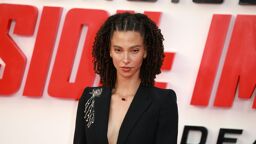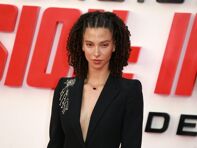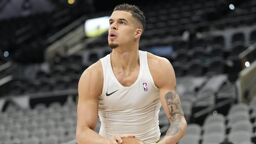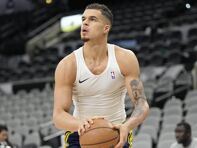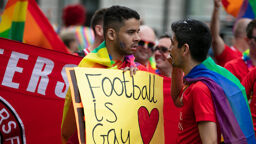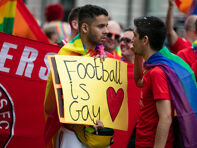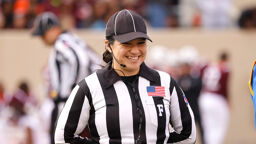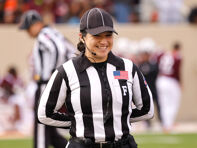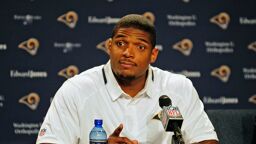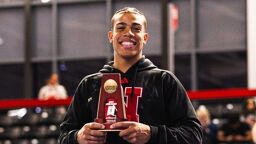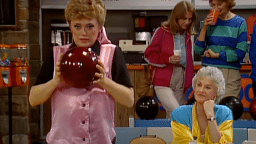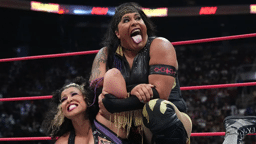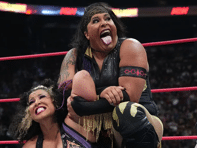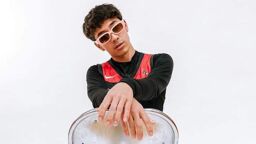Andrew Ford was questioned and fetishized when he came out as bisexual. The gay community insisted he wasn’t being honest with himself; women at clubs started to excitedly fantasize about hooking up with two guys at the same time.
All the while, the soccer standout stayed true to himself. Ford came out his freshman year at Malone University, a small Christian liberal arts college in Canton, Ohio — home of the Pro Football Hall of Fame. His friends and teammates were accepting, which was an incredible relief. But his journey into the LGBTQ community was a little more rocky.
“I got a lot of pressure from the gay community,” Ford told me recently on the phone. “I felt like I was misunderstood, and didn’t know who I was.”
Ford is one of an increasing number of openly bisexual college-aged athletes whom we’ve profiled recently on Outsports. Despite some surveys showing more Americans identify as bisexual than either gay or lesbian, there is a dearth of bi visibility in pop culture and sports.
As bi sportswriter Jeff Rueter challenged me: “name a bisexual man, and don’t say Frank Ocean.”
These kick-ass kids are going to change that.
Biphobia is real
Let’s start here: Biphobia is real. It manifests itself in gestures as seemingly fleeting as dismissive jokes, and actions as harrowing as outright physical violence. Bisexual people typically suffer significantly higher rates of depression and anxiety, domestic violence, sexual assault, and poverty than lesbians, gay men, or straight cisgender people, according to the Human Rights Campaign.
A black-and-white society, most of us grow up with the notion people are either straight or gay. Those attitudes have historically prevailed in the LGBTQ community, too.
Alex Keuroghlian, the Director of the National LGBTQIA+ Health Education Center at the Fenway Institute, says bisexual people can be looked at skeptically.
“Within LGBTQIA+ communities, there has historically been a stigma toward bisexual people, and the false notion that they’re really gay and lesbian people who haven’t accepted that about themselves,” he said.
Megan Duthart, a rower at Washington State University who identifies as both bi and queer, has experienced the stigma first-hand. She says she thinks bisexual people are often excluded in the LGBTQ community.
“I’ve struggled a little bit with being identified as an ‘other’ in the community with the term ‘bisexuality,’” she said.
Why are bi people targeted for erasure?
More people are identifying as bisexual. Over three percent of U.S. adults say they’re bi, according to the 2018 General Social Survey. That’s three times the number as 2008.
And yet, bi people are still targeted for erasure. One of the ways it happens is through language. When people see same-sex couples, for example, they may be inclined to label them as “gay” or “lesbian,” without considering that one or both of the people could identity as bi.
While Americans’ attitudes about sexuality are evolving, many still adhere to more binary definitions of sexual orientation. A recent YouGov poll found 41 percent of American adults don’t think sexuality is a spectrum (conversely, 37 percent think it is).
As Ford puts it, bisexuality is stereotypically viewed as “the stepping stone stage.” That ties into one of the more insidious aspects of bi-erasure: the belief that it’s just a phase. It’s a line Ford recalls hearing many times, from both men and women.
“(Gay men) said, ‘I came out as bisexual first. It’s just a phase, you won’t be there long,’” Ford said. “I was also scared how women would think about it. They wanted to change me. Some of them wanted to use it as a thrill they were seeking.”

When professional hockey player Zach Sullivan came out as bi, his father told him it meant he was still making up his mind.
“I remember what my dad said when I told him,” Sullivan said. “‘Well, you aren’t all the way there. You haven’t really decided.’ I was like, ‘no, I know I’m attracted to both genders. I’m not halfway towards coming out as gay.’”
The bi burden
Every LGBTQ person can relate to the fear and anxiety of coming out. But for most of us, once we do it, it’s over.
That’s not the case for bi people.
“We have to keep coming out to our significant others, whether it’s a man or a woman,” Ford said. “If you’re gay and you start dating a gay, you’re not going to be like, ‘I have to tell you something: I’m gay.’ They’re going to be like, ‘no shit.’”
And once bi people do come out, they could get charged with being greedy — the sexual equivalent of having their cake and eating it, too. The insult angers Sullivan.
“The majority of people in the LGBT+ community have struggled with their sexuality, and when they finally become comfortable enough to come out in the open with their sexuality, I don’t think the first thing to say to someone who’s come out as bisexual is they’re greedy,” Sullivan said. “I took over 10 years to get to where I am.”
Duthart finds the concept of bisexuality can be difficult to explain. She largely identifies as queer.
“I’ve had coaches question whether I’m rebelling or going through a phase,” she said. “Then when I explain the whole queer aspect, they’re like, ‘Oh, OK. That seems more justified.’ I don’t want to have to justify those things, but I sort of have to.”
Changing attitudes
Jack Storrs came out as bisexual last year as a college football captain. His teammates at Pomona-Pitzer rallied around him, and wore Pride decals on their helmets.
But even some who were supportive suggested he was on his way to identifying as gay. Storrs said he couldn’t hide his feelings for men anymore, and came out because he wanted to explore.
Maybe he was gay, maybe he wasn’t. The questions didn't bother him. He was a relieved to have the dialogue.
“It was killing me on the inside,” Storrs said. “It got to the point where I was like, ‘screw it.’ This is who I am, and this was meant to be.”
Nowadays, Storrs says he’s more towards the “gay end of the spectrum,” and expects the fluidity to continue.
He’s cool with that, and numbers show his peers are, too. Generation Z is among the most progressive and diverse in U.S. history. A 2018 study from Ipsos Mori shows only 66 percent of young people today identify exclusively as heterosexual.
Young people have a better understanding of how sexuality can evolve, says Keuroghlian.
“There’s been less of a reflex to box people in, and categorize people in ways that could be static,” he said. “A key part of all of this is not projecting behavior or projecting attraction. People tell us — they self-identify that’s who they are. And we have to honor that.”
Visibility challenges misperceptions
But to get back to Rueter’s question: can you name a famous out bisexual person besides Frank Ocean?
It’s challenging, and the lack of bi visibility may be one of the biggest contributors towards bi-erasure. But that is changing. Each person who comes out as bisexual has the ability to change perceptions within their own communities — and many young athletes are.
Bri Tollie, a bisexual college basketball player at Southern Methodist University, wrote in her coming-out story she refuses to conform.
“It is important to be visible because everyone is unique,” she wrote. “Our uniqueness means no one should not have to give up a part of themselves to conform. It is called self-respect.”

Growing up, Storrs tried to shut off his attraction to guys. He told himself it wasn’t a big deal, but the angst became all-encompassing.
Storrs is done hiding any part of himself. He did that for far too long, and is now out for all to see.
“I am bisexual, and my point is, I don’t really give a shit what anybody else thinks,” Storrs said. “This is who I am, and I don’t have to figure it out, but the reason I’m coming out is to figure it out, or at least get to a point where I’m comfortable.”
With their stories, these young bi athletes are making it more comfortable for bi people every single day.




